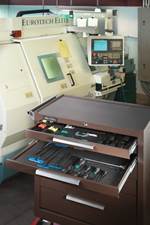The Connection Between Labor and Lean
Lean manufacturing is about identifying and optimizing variables that affect cost and time. This same systemization can make the process easier to staff.
"Lean manufacturing" is a little bit misnamed. A manufacturer can become leaner without this necessarily being a good thing. Plus, some lean manufacturers actually add weight. That was the case with Bryco Machine (see Editor's Picks at right), which committed to "lean" partly so it could add more equipment.
No, "going lean" might instead be characterized as "going systemized" or "going optimized." The "weight" that gets cut in lean manufacturing consists of the excesses that result from key variables being unidentified or out of control. For example, if setup time is uncertain, then inventory may have to accumulate just to fill urgent orders. Or, if the layout of the facility is unexamined, then jobs may travel long distances through the shop. "Lean" has to do with making the variables seen and certain, then trying to reduce their impact. Cost and time savings are two benefits—and not the only ones.
Another benefit I’ve seen is this: In facilities committed to lean, there tends to be less pressure about a particularly widespread challenge of CNC machining today: finding skilled employees.
You are no doubt aware of this challenge. The reason lean manufacturing can help is probably also apparent to you. By making the process more systemized, specific tasks become more defined and therefore easier to teach. The shop can more readily make use of less skilled employees.
However, in noticing this, it’s interesting to reflect on what those skilled machining employees have been doing all along. One way to think of their work is that they navigate those undefined variables. The skilled machinist examining a print can judge what machines and tooling in the shop are needed to make the part, as well as how to set up and program each operation. By defining the steps necessary to the job in this way, the traditional machinist does not just execute the process, but also helps conceive it.
That is why these same skilled employees have proven essential for many shops making the transition to lean. The machinists know what decisions have to be made on the shop floor; they are the ones making them. They can also judge what changes to the process might truly and reliably save time. As a result, a common element of "going lean" in many facilities is the team that includes experienced machinists, some perhaps close to retirement, that works out what a systemized production process for the facility really ought to look like. In contributing their experience toward helping to engineer such a process—one that has clear organization and defined tasks—part of what these machinists are doing is helping prepare the company for a future in which it can’t rely on having quite so many employees who can navigate the variables.
Related Content
-
Will the “Great Resignation” Become an Opportunity for Manufacturers? Get Ready for the Returning 3 Million
The Great Resignation will become a Great Reapplication when employees currently able to stay out of the workforce return to it looking for something better. Machining employers that are already evaluating candidates for fit, without demanding specific skills coming in, might be positioned well to draw upon this wave.
-
How to Grow the Business with Real-Time Job Status Data
ERP systems that focus on making data more accessible can improve communication within a shop, reducing wasteful errors and improving capacity.
-
A Career at the Top Helps Rebuild a Job Shop
A new approach to management propels expansion into Swiss-type and multitasking machining work.

.jpg;width=70;height=70;mode=crop)








.png;maxWidth=300;quality=90)


